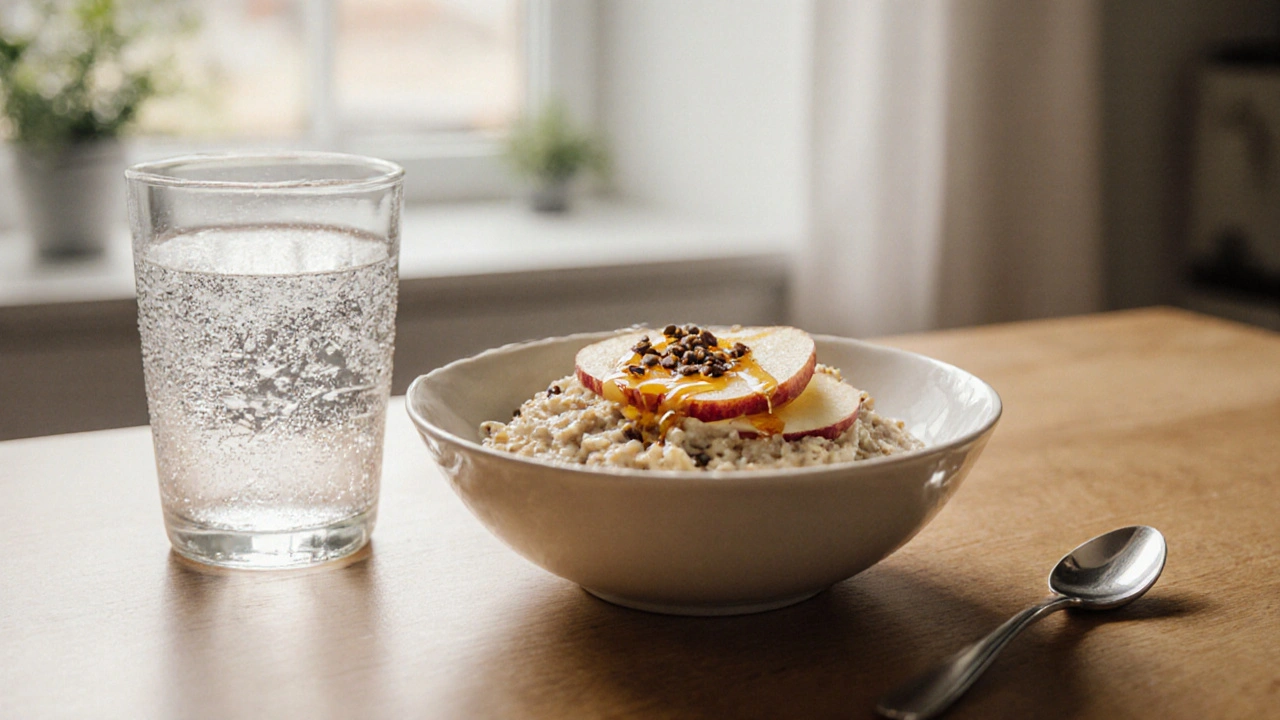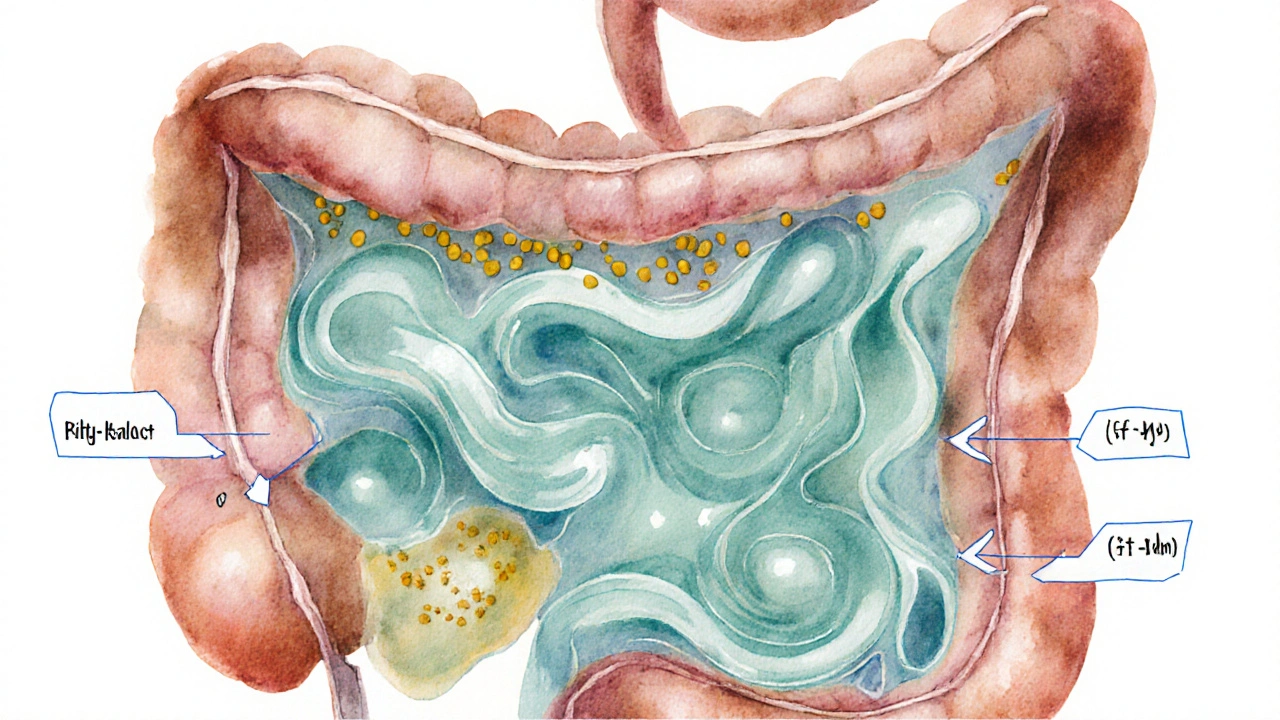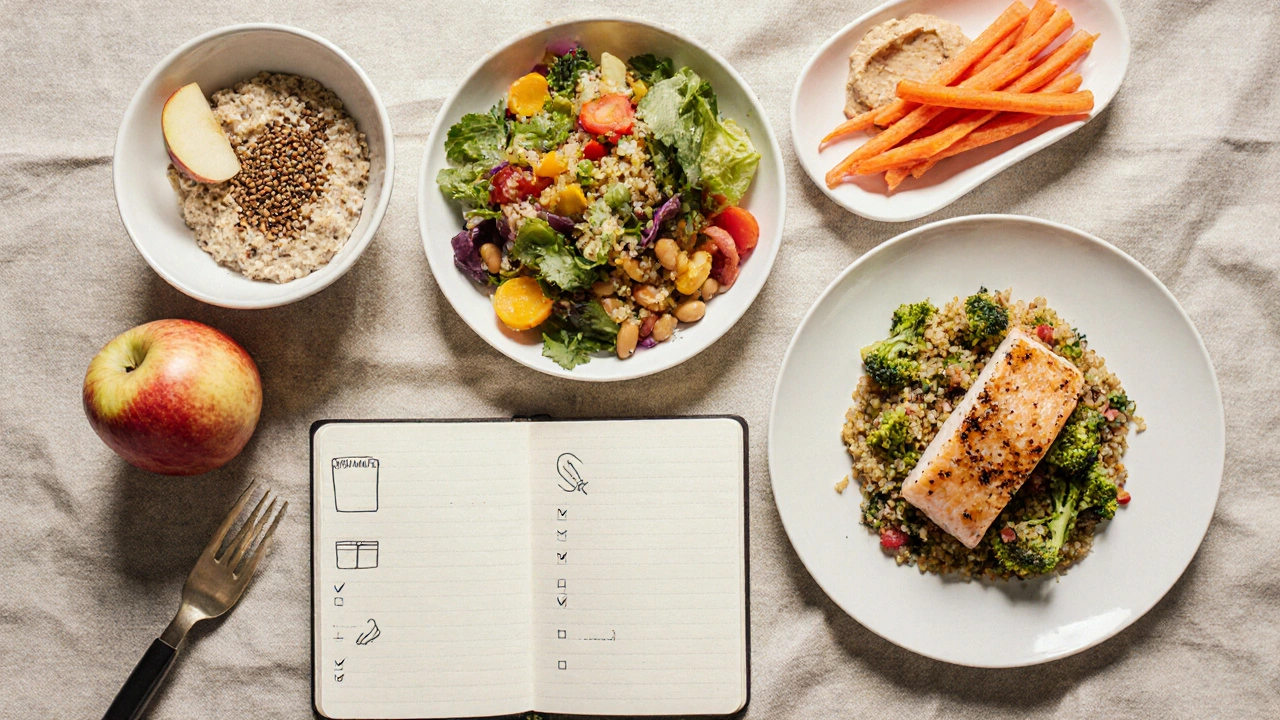
Cholesterol-Friendly Fiber Calculator
This tool helps you track your daily soluble fiber intake to support healthy cholesterol levels. Enter the foods you typically eat in a day to calculate your total intake and see how close you are to the recommended 5–10g of soluble fiber per day.
Foods with Soluble Fiber
Your Results
How It Works
Soluble fiber helps lower LDL cholesterol by binding bile acids in the gut. Each gram of soluble fiber can help reduce cholesterol by approximately 0.05%.
To achieve a 5–10% reduction in LDL cholesterol, aim for 5–10 grams of soluble fiber per day. This calculator helps you estimate your intake from common foods.
Remember to increase fiber intake gradually and drink plenty of water to avoid digestive discomfort.
Key Takeaways
- Soluble fiber can bind cholesterol in the gut and help lower LDL levels.
- Aim for at least 25-30g of dietary fiber each day, with half of it coming from soluble sources.
- Whole grains, oats, beans, fruits and vegetables are the most effective cholesterol‑lowering foods.
- Introduce fiber slowly and pair it with plenty of water to avoid digestive discomfort.
- Track your intake using a simple checklist to stay on target.
High blood cholesterol is a silent risk factor for heart disease, and many people think medication is the only way to fix it. In reality, what you put on your plate can shift numbers dramatically. Adding the right kind of fiber to a heart‑healthy diet is one of the most evidence‑backed strategies for pulling LDL (the “bad”) cholesterol down without the side‑effects of drugs.
What Exactly Is dietary fiber?
Dietary fiber is the indigestible part of plant foods that passes through the stomach and small intestine mostly unchanged. It comes in two main flavors: soluble and insoluble. Both help keep you regular, but soluble fiber plays the starring role when it comes to cholesterol. Think of fiber as a sponge that soaks up cholesterol and bile acids, dragging them out of the body before they can hitch a ride back into the bloodstream.
How Fiber Lowers Cholesterol: The Science Made Simple
When you eat soluble fiber, it forms a gel‑like substance in your gut. This gel binds to bile acids-those tiny packets the liver uses to digest fat. Since bile acids contain cholesterol, pulling them out means the liver has to dip into the bloodstream’s cholesterol stores to make more. That process gradually reduces LDL levels.
In contrast, insoluble fiber adds bulk and speeds up transit time, which helps with weight control-a secondary benefit for heart health. Both types together improve the gut microbiome, and a healthier gut can lower inflammation, another piece of the heart‑disease puzzle.

Soluble vs. Insoluble Fiber: A Quick Comparison
| Feature | Soluble Fiber | Insoluble Fiber |
|---|---|---|
| Primary Benefit | Lowers LDL cholesterol by binding bile acids | Promotes regular bowel movements |
| Typical Sources | Oats, barley, beans, lentils, apples, citrus peels, psyllium | Whole‑grain breads, wheat bran, nuts, seeds, vegetable skins |
| Texture | Gel‑forming when mixed with water | Coarse, adds bulk |
| Effect on Blood Sugar | Slows glucose absorption, helpful for diabetics | Minimal direct effect |
Top Cholesterol‑Lowering Fiber Foods
Here are the everyday items that pack the biggest soluble‑fiber punch:
- Oats - 1 cup cooked delivers about 4g soluble fiber (β‑glucan).
- Barley - Another β‑glucan powerhouse, perfect in soups.
- Legumes (beans, lentils, chickpeas) - 1/2cup cooked offers 6-8g mixed fiber, half soluble.
- Apples (with skin) - 4g soluble pectin per medium fruit.
- Citrus fruits (oranges, grapefruits) - rich in soluble pectin.
- Psyllium husk - Up to 5g soluble fiber per tablespoon; great in smoothies.
Don’t forget the “supporting cast” of whole‑grain breads, brown rice, nuts, seeds, and veg‑based skins that add insoluble fiber and keep your digestion humming.
How to Build a Fiber‑Rich Day: Simple Steps
- Start with a bowl of oatmeal topped with sliced apple and a sprinkle of flaxseed. Aim for 5g soluble fiber at breakfast.
- Swap white rice for brown rice or barley in lunch salads. Add a half‑cup of black beans for an extra 3g mixed fiber.
- Snack on raw carrot sticks with hummus (chickpea‑based) - a combo of soluble and insoluble fiber.
- For dinner, grill a piece of fish and serve it over a bed of quinoa mixed with sautéed broccoli and a spoonful of psyllium‑infused sauce.
- End the day with a cup of herbal tea and a tablespoon of ground psyllium mixed in warm water.
Spread the total fiber intake across meals to avoid bloating. Aim for 3-4g soluble fiber per meal, which adds up to the recommended 25-30g total daily fiber for most adults.

Common Mistakes & How to Fix Them
- Jumping to high‑fiber too fast. Sudden spikes can cause gas and cramps. Increase intake by 5g each week.
- Skipping water. Fiber pulls water into your gut; without enough, you risk constipation. Drink at least 8cups of fluid daily.
- Choosing low‑fiber “healthy” snacks. Granola bars often contain added sugars and little actual fiber. Read labels - aim for ≥3g fiber per serving.
- Ignoring portion sizes. A cup of cooked beans is great, but five cups a day adds unnecessary calories.
Quick Daily Fiber Checklist
- Breakfast: 5g soluble fiber (oats, fruit, flax)
- Mid‑morning snack: 2g fiber (nuts or veg sticks)
- Lunch: 7g mixed fiber (whole grains + legumes)
- Afternoon snack: 2g fiber (apple or berries)
- Dinner: 8g mixed fiber (vegetables + whole grain)
- Evening: 1g soluble fiber (psyllium in water)
- Total: 25-30g fiber, ~15g soluble
Check off each line daily. Within weeks you should see a modest drop in LDL - often 5-10% - especially when paired with a low‑saturated‑fat diet and regular exercise.
Frequently Asked Questions
How much soluble fiber do I need to lower cholesterol?
Research shows that 5-10g of soluble fiber per day can reduce LDL by 5-10%. That’s roughly a half‑cup of cooked beans, a bowl of oatmeal, or a large apple daily.
Will fiber pills work as well as food?
Supplements like psyllium can boost soluble fiber, but whole foods also provide vitamins, minerals, and phytochemicals that aid heart health. Use supplements only to fill gaps.
Can a high‑fiber diet affect my medication?
Yes, especially cholesterol‑lowering drugs (statins). Fiber can enhance their effect, so discuss any diet changes with your doctor to adjust dosages if needed.
Is there a risk of too much fiber?
Excessive fiber (over 50g per day) can lead to nutrient malabsorption and gut discomfort. Stick to the 25-30g range and balance with fluids.
Do all fibers lower cholesterol equally?
No. Soluble fibers (β‑glucan, pectin, psyllium) are the most effective at binding bile acids. Insoluble fibers aid digestion but have a limited direct impact on cholesterol.
Comments (18)
-
Derek Dodge October 9, 2025
I tried the oats thing the other day and felt a subtle energy boost.
-
AARON KEYS October 12, 2025
Soluble fiber is also abundant in legumes such as beans and lentils, as well as in fruits like pears and citrus, and adding a spoonful of psyllium husk can further enhance the effect.
-
Melissa Shore October 14, 2025
Soluble fiber forms a viscous gel when it mixes with water in the gut.
This gel traps bile acids that are made from cholesterol.
When the body reabsorbs fewer bile acids it must use more cholesterol to make new ones.
Consequently the amount of LDL cholesterol circulating in the blood drops.
Each gram of soluble fiber can remove roughly half a milligram of LDL per deciliter.
Oats contain about one gram of soluble fiber per half‑cup serving.
Barley provides a similar amount and can be used as a base for soups.
Beans are a powerhouse delivering two to three grams per half‑cup.
Apples with skin supply around one gram and also give you a sweet crunch.
Citrus fruits add a tangy flavor while contributing a gram of soluble fiber.
Psyllium husk is the most concentrated source with up to five grams per tablespoon.
Gradually increasing fiber intake helps avoid gastrointestinal discomfort.
Water is essential because fiber expands and can cause blockage if fluids are insufficient.
The calculator in the post helps you visualize how close you are to the recommended range.
Aim for at least five grams daily to see a modest reduction in LDL over weeks.
-
Maureen Crandall October 16, 2025
Listen you dont need a fancy calculator just dump a cup of oatmeal in your bowl and call it a day
-
Michelle Pellin October 18, 2025
The symphony of soluble fibers orchestrates a remarkable reduction in LDL, painting a vibrant tableau of cardiovascular resilience that warrants reverent admiration.
-
Keiber Marquez October 20, 2025
America should prioritize oat consumption its a true patriot move for a strong heart.
-
Shivaraj Karigoudar October 22, 2025
From a nutritional epidemiology standpoint, the inclusion of beta‑glucan rich grains such as oat and barley aligns with the metabolic pathways that modulate enterohepatic circulation of bile acids; this mechanistic insight underscores the importance of integrating such functional foods into dietary patterns, especially in populations transitioning from high‑fat Western diets to more plant‑centric regimens, thereby fostering a holistic improvement in lipid profiles while simultaneously addressing gut microbiota diversity which further amplifies short‑chain fatty acid production, a beneficial cascade that resonates with both cardiometabolic health and systemic inflammation mitigation.
-
Matt Miller October 24, 2025
Adding a half‑cup of beans to lunch is an easy way to boost soluble fiber.
-
Fabio Max October 25, 2025
Every extra gram of fiber is a step toward a healthier heart, keep it up!
-
Darrell Wardsteele October 27, 2025
The math in the calculator is spot on but make sure you use consistent units you dont want to mix grams with milliliters the results will be skewed otherwise.
-
Madeline Leech October 29, 2025
Honestly if you’re not tracking your fiber you’re basically ignoring the simplest heart‑health hack out there.
-
Barry White Jr October 30, 2025
Solid advice.
-
Andrea Rivarola November 1, 2025
I have always found that the process of gradually increasing one’s soluble fiber intake can be both a culinary adventure and a physiological benefit; starting with modest portions of oatmeal in the morning and pairing it with a sliced apple provides a gentle introduction, while later in the day incorporating a lentil soup or a barley risotto ensures a steady supply of beta‑glucan, which over weeks can noticeably lower LDL cholesterol, and this method also encourages mindful eating habits that often translate into broader lifestyle improvements such as reduced processed food consumption and increased hydration, all of which synergistically support cardiovascular wellness.
-
Tristan Francis November 3, 2025
They don’t tell you that big pharma wants you to ignore fiber because it hurts their profit.
-
Keelan Walker November 4, 2025
Hey folks 😃 Let’s celebrate the power of soluble fiber 🌾 It’s amazing how just a bowl of oats or a spoonful of psyllium can shift your cholesterol numbers 📈 Keep adding fruits like apples 🍎 and beans 🫘 and watch the change 🚀 Remember to drink water 💧 and stay consistent 🙌
-
Heather Wilkinson November 5, 2025
Great tip! 👍 Adding fiber is a simple win for heart health 🌟
-
Henry Kim November 7, 2025
For those new to tracking, start with the calculator’s default values and adjust gradually; it makes the process less overwhelming.
-
Neha Bharti November 8, 2025
In the pursuit of health, small daily choices compose the larger narrative of wellbeing.
